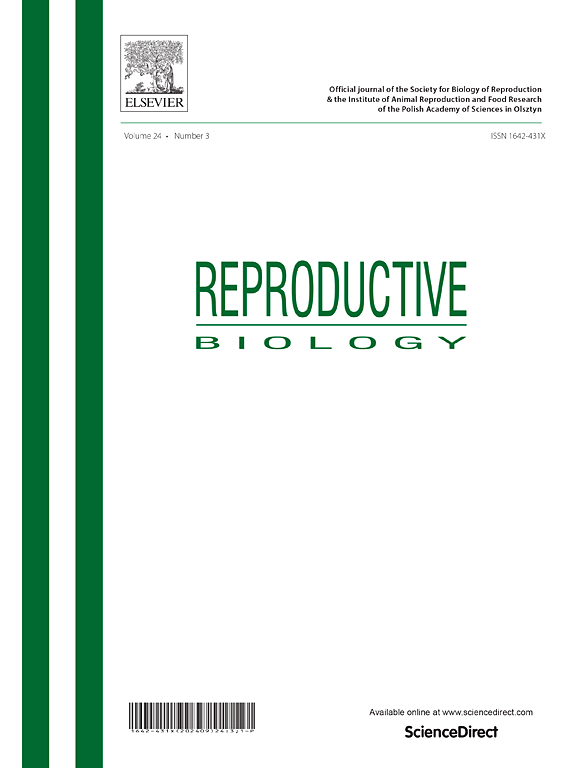慢性应激会阻碍壁虎半爪蜥季节性和促性腺激素诱导的卵巢再发育。
IF 2.5
3区 生物学
Q3 REPRODUCTIVE BIOLOGY
引用次数: 0
摘要
爬行动物的应激-生殖轴的神经内分泌调控非常复杂,因为这些动物采取的生殖策略多种多样。因此,爬行动物应激影响生殖轴的内在机制仍然不清楚。在本研究中,我们考察了应激对热带和亚热带家壁虎(Hemidactylus frenatus)繁殖和非繁殖周期中季节性和FSH诱导的卵巢复旧的影响。在卵巢周期的再发育阶段,蜥蜴暴露于各种应激源(搬运、禁闭、追逐和噪音)会导致垂体正中突起和/或垂体远端旁的促肾上腺皮质激素释放激素(CRH)和促肾上腺皮质激素(ACTH)免疫反应性(ir)含量的百分比显著增加、同时,与实验对照组相比,促性腺激素释放激素(GnRH)-ir 含量在中脑和垂体上部的释放量、生殖床中卵原细胞的数量以及卵巢中第 IV 期和第 V 期(卵黄形成期)卵泡的缺失均显著减少。在非繁殖期,用FSH处理应激蜥蜴不会刺激IV期和V期卵泡的发育,而只用FSH处理的蜥蜴则没有这种现象。总之,这些研究结果表明,暴露于应激源可防止季节性卵巢复旧,这可能是通过抑制下丘脑GnRH向ME和PD的释放和/或直接在卵巢水平介导的。本文章由计算机程序翻译,如有差异,请以英文原文为准。
Exposure to chronic stress impedes seasonal and gonadotropin-induced ovarian recrudescence in the gecko Hemidactylus frenatus
The neuroendocrine regulation of the stress-reproductive axis in reptiles is complex due to the diverse reproductive strategies adopted by these animals. Consequently, the underlying mechanisms by which stress can affect the reproductive axis remain opaque in reptiles. In the present study, we examined the effect of stress on the seasonal and FSH-induced ovarian recrudescence during the breeding and non-breeding phases of the cycle in the tropical and subtropical house gecko Hemidactylus frenatus. During the recrudescence phase of the ovarian cycle, exposure of lizards to various stressors (handling, confinement, chasing, and noise) caused a significant increase in the percentage of corticotropin-releasing hormone (CRH) and adrenocorticotropic hormone (ACTH)-immunoreactive (ir) content in the median eminence (ME) and/or pars distalis of the pituitary gland (PD), concomitant with a significant decrease in the release of gonadotropin-releasing hormone (GnRH)-ir content into the ME and PD, and number of oogonia in the germinal bed and absence of the stage IV and V (vitellogenic) follicles in the ovary compared to experimental controls. During the non-breeding phase, treatment of stressed lizards with FSH did not stimulate the development of stage IV and V follicles, in contrast to their appearance in FSH-only-treated lizards. Collectively, these findings suggest that exposure to stressors prevents the seasonal ovarian recrudescence, possibly mediated through the suppression of hypothalamic GnRH release into the ME and PD and/or directly at the level of the ovary.
求助全文
通过发布文献求助,成功后即可免费获取论文全文。
去求助
来源期刊

Reproductive biology
生物-生殖生物学
CiteScore
3.90
自引率
0.00%
发文量
95
审稿时长
29 days
期刊介绍:
An official journal of the Society for Biology of Reproduction and the Institute of Animal Reproduction and Food Research of Polish Academy of Sciences in Olsztyn, Poland.
Reproductive Biology is an international, peer-reviewed journal covering all aspects of reproduction in vertebrates. The journal invites original research papers, short communications, review articles and commentaries dealing with reproductive physiology, endocrinology, immunology, molecular and cellular biology, receptor studies, animal breeding as well as andrology, embryology, infertility, assisted reproduction and contraception. Papers from both basic and clinical research will be considered.
 求助内容:
求助内容: 应助结果提醒方式:
应助结果提醒方式:


